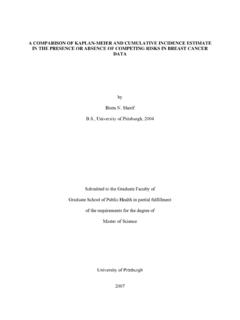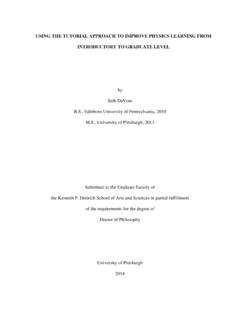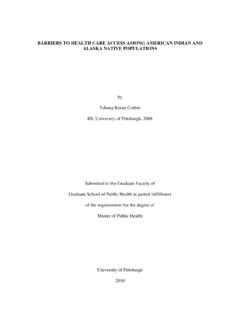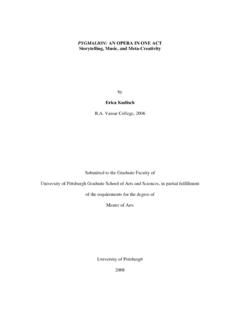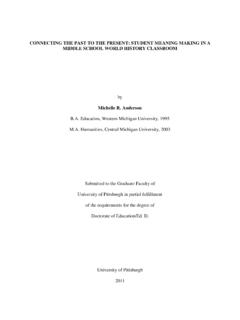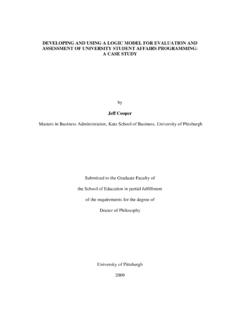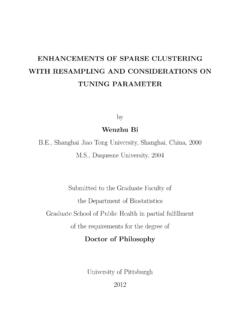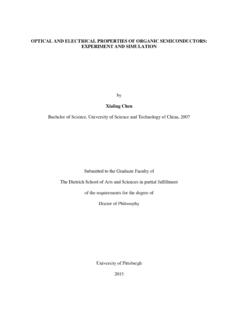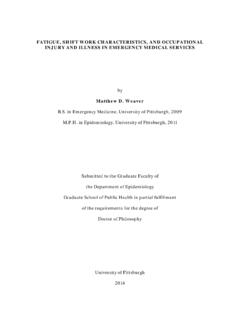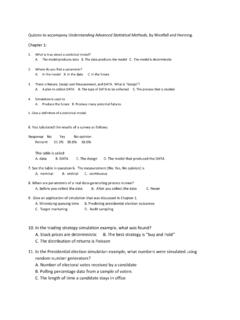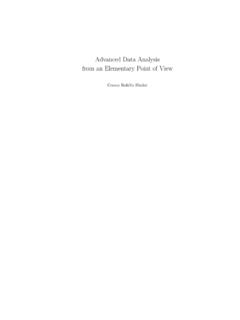Transcription of APPLICATION OF ADVANCED STATISTICAL METHODS IN AN …
1 APPLICATION OF ADVANCED STATISTICAL METHODS IN AN AGING DATASET by Karina Nelly Alvarez BS, Carnegie Mellon University, 2009 Submitted to the Graduate Faculty of Department of Biostatistics Graduate School of Public Health in partial fulfillment of the requirements for the degree of Master of Science University of Pittsburgh 2012 ii UNIVERSITY OF PITTSBURGH GRADUATE SCHOOL OF PUBLIC HEALTH This thesis was presented by Karina Nelly Alvarez It was defended on April 13, 2012 and approved by Thesis Advisor: Lisa Weissfeld, PhD, MA Professor Biostatistics Graduate School of Public Health University of Pittsburgh Committee Member: Sachin Yende, MD, MS Associate Professor Critical Care Medicine University of Pittsburgh Medical School University of Pittsburgh Committee Member: Caterina Rosano, MD, MPH Associate Professor Epidemiology Graduate School of Public Health University of Pittsburgh iii Copyright by Karina N.
2 Alvarez 2012 iv APPLICATION OF ADVANCE STATISTICAL METHODS IN AN AGING DATASET Karina Nelly Alvarez, University of Pittsburgh, 2012 The focus of this thesis was to explore the APPLICATION of ADVANCED STATISTICAL METHODS in the Ginkgo Evaluation of Memory (GEM) Study. GEMS enrolled 3,069 participants age 75 or older with normal cognition or mild cognitive impairment. Those with dementia were excluded from participation. After extensive medical and neuropsychological screening, participants were randomly assigned to receive twice-daily doses of either 120 milligrams of ginkgo extract or an identical-appearing placebo.
3 The 240 milligrams daily dose of ginkgo was selected based on current dosage recommendations and prior clinical studies indicating possible effectiveness at this dosage. The products used in the study were supplied by Schwabe Pharmaceuticals, a German company. We focused on two METHODS , a flexible Cox model (Gray s model) and a trajectory procedure based on a mixture model that is implemented in the SAS procedure P ROC TRAJ. The spline-based extension of the Cox model was applied to biomarker data; specifically: Cystatin-C , Beta Amyloid 40, Beta Amyloid 42, and a ratio of Beta Amyloid 42 over Beta Amyloid 40.
4 We wanted to determine if the estimate of the log-hazard ratio changed over time for each of the biological measures. The trajectory analysis was used to determine if a patient s illness trajectory continued on the same path towards demented or non-demented before experiencing a pneumonia event. The trajectory analysis was applied to the longitudinal trajectories of activities of daily living (ADL), independent activities of daily living (IADL) and modified mini-mental status exam (3 MSE). The Cox Spline analysis resulted in no statistically significant information added to the models using the spline analysis.
5 Trajectory analysis v concluded that patients on a downward trajectory at baseline only escalated before the pneumonia event. As the average life expectancy continues in increase in humans, it is important to evaluate STATISTICAL METHODS in the elderly population to identify subpopulations that need more medical attention than the population at large. Thus, the public health significance of this thesis is that by identifying these subgroups that are distinctly different from the overall population, we can provide preventative care where needed more efficiently. vi TABLE OF CONTENTS INTRODUCTION.
6 1 RCT DESIGN .. 2 OBJECTIVES .. 3 Pneumonia .. 3 Dementia .. 3 METHODOLOGY .. 4 PARTICIPANTS .. 4 MEASURES .. 4 EXPERIMENTAL DESIGN .. 5 MEDICATION ADMINISTRATION .. 5 DATA ANALYSIS .. 6 Trajectory Models .. 6 Trajectory Criteria .. 9 Cox Spline Models .. 10 Cox Spline Assumptions & Diagnostics .. 11 Missing Data .. 11 RESULTS .. 13 DEMOGRAPHIC CHARACTERISTICS .. 13 vii TRAJECTORY ANALYSIS .. 13 ADL/IADL .. 14 18 COX SPLINE ANALYSIS .. 20 Beta Amyloid 40 .. 21 Beta Amyloid 42 .. 22 Beta Amyloid (40/42) .. 23 24 Biomarker Comparison .. 25 DISCUSSION .. 26 CONCLUSIONS.
7 26 Trajectory Analysis .. 26 Flexible Cox Model .. 26 PUBLIC HEALTH ASPECT .. 27 APPENDIX A: SUMMARY VARIABLES .. 28 APPENDIX B: GLOSSARY OF ACRONYMS .. 32 APPENDIX C: SAS SOURCE CODE .. 33 APPENDIX D: R SOURCE CODE .. 37 BIBLIOGRAPHY .. 39 viii LIST OF TABLES Table 1. Group Membership for ADL .. 15 Table 2. Group Membership for IADL .. 17 Table 3. Group Membership for 3 MSE .. 19 Table 4. Biomarker Comparison .. 25 Table 5. Comparison of dementia cases to non-cases at baseline from 2000 to 2008 .. 29 Table 6. Log Hazard Ratio for Beta-40 over time .. 30 Table 7. Log Hazard Ratio for Beta-42 over time.
8 30 Table 8. Log Hazard Ratio for Beta ratio (40/42) over time .. 31 Table 9. Log Hazard Ratio for Cystatin-C over time .. 31 ix LIST OF FIGURES Figure 1. Adapted from Jones s Graphical Representation of the Independence Assumption in Trajectories (Jones, Nagin and Roeder) .. 8 Figure 2. ADL Trajectory .. 16 Figure 3. IADL Trajectory .. 18 Figure 4. 3 MSE Trajectory .. 20 Figure 5. Beta-40 Log Hazard Ratio over time with 95% CI .. 22 Figure 6. Beta-42 Log Hazard Ratio over time with 95% CI .. 22 Figure 7. Beta ratio (42/40) Log Hazard Ratio over time with 95% CI .. 23 Figure 8. Cystatin-C Log Hazard Ratio over time with 95% CI.
9 24 1 INTRODUCTION Ginkgo biloba is among the most extensively studied herbs in use today. There have been claims that the herb helps to treat blood disorders and enhance memory. Some scientific studies have found evidence that supports these claims, others have found no association. Regardless of the conflicting findings, it is still believed by many that ginkgo may be help treat dementia, including Alzheimer's disease, and intermittent poor circulation in the legs and shows promise for enhancing memory in older adults (University of Maryland Medical Center). In an attempt to formally answer questions about Gink go biloba s effectiveness as a treatment for a variety of illnesses, a randomized, double-blind clinical trial was created.
10 The trial is known as the Ginkgo Evaluation of Memory Study (GEMS). The primary focus of the study was to determine the effect of 240mg/day Ginkgo biloba in decreasing the incidence of dementia and specifically Alzheimer's disease (AD). Secondary outcomes included: number of participants with the indicated cardiovascular disease or mortality and the progression of cognitive decline in standardized z-score scale (Steven T. DeKosky). More information about the trial can be found at , using identifier NCT00010803. From this trial, came a rich dataset. The dataset was filled with years and years of measures from the same 3,069 participants that included everything from age, gender and BMI to information on cardiovascular illnesses.
